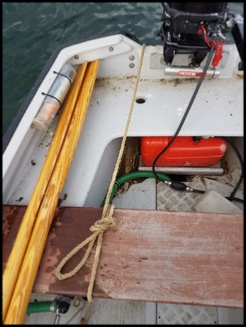BOAT FISHING
BOAT FISHING INDEX
BACK TO TABLE OF CONTENTS
ANCHORING
Make sure the venue permits anchoring, which should be obvious by the presence or otherwise of an anchor in the boat. It is important to pay out extra rope to allow the anchor to lie flat and let all the chain lie on the bottom. This is essential when a strong wind is blowing, otherwise the anchor could drag. It is the weight of the chain that causes the anchor to dig in to the bottom and get a secure hold. You need to take this extra length of rope into account when positioning the boat, or else you will end up floating quite a way from your intended location.
You'll need to give it all a few moments to settle before you can be sure that you have got everything right. I've had many times when I thought it was all OK, only to find that the boat finally came to settle too shallow or too deep - and sometimes nowhere near where I had intended to fish! If that happens, don't be afraid to pull the anchor up and try again. Finally, secure the anchor rope to the rowlock with a simple clove hitch. Using half a dozen granny knots will ruin the end of the day when you come to undo them again, especially after the force of the wind on the boat has tightened everything up for you. Even worse is slipping the tangled mess off the rowlock and leaving it lying in the boat. Imagine how you'd feel if someone had left that for you to sort out as the first job of the day.
Using the rowlock is the standard method of anchoring when fishing from a boat. But, over the years, I developed a slightly different method, which I believe works much better. The biggest problem with having the anchor rope tied off at the rowlock and fishing from the side of the boat is yaw. Yaw is the tendency of a boat to swing at its mooring to try and ease the force of the wind on its upwind side. It will swing one way - but that side will then swing nearer to the wind so will catch the wind and swing away, until the other side is nearer to the wind and so on. All of this motion can cause the boat to swing in a wide arc across the water.
Normally this is not a problem, but when fly fishing it can be very frustrating to cast directly away from the side of the boat, only to find that the boat then swings and your fly line is now lying almost down the side of the boat. Additionally, if you want to use a depth critical fishing technique - for example counting the line down through the water - then the yaw of the boat will pull your fly line around with it and ruin your system.
The most stable way to moor a boat is with its stern to the wind. This is more stable than mooring bow on, as the wind will still try and cut to one side of the bow or the othe r. The small face presented by the stern acts as a brake and effectively eliminates yaw almost completely. So I would tie the anchor rope off at the stern of the boat. This can be achieved at the point where the engine is attached, which is designed to handle the forces involved - or by tying the anchor rope around the thwart as in the picture. With this set-up you then fish from the front of the boat - literally casting directly over the bow of the boat. Your seat board is positioned so that you sit facing forwards in the front of the boat and retrieve your line over the bows.
r. The small face presented by the stern acts as a brake and effectively eliminates yaw almost completely. So I would tie the anchor rope off at the stern of the boat. This can be achieved at the point where the engine is attached, which is designed to handle the forces involved - or by tying the anchor rope around the thwart as in the picture. With this set-up you then fish from the front of the boat - literally casting directly over the bow of the boat. Your seat board is positioned so that you sit facing forwards in the front of the boat and retrieve your line over the bows.
This system of fishing from the bow is most effective when there is one person in the boat but can still be used with two in the boat. One person sits forward and to the left, while the person in the stern sits to the right. These positions relate to right handed anglers and are reversed for left handers. The person in the bow casts slightly across the wind, the person at the rear avoiding casting directly over the person in the bows. A G-clamp can be used to set the boat at a perfect angle. Clamp it to the gunwale, using a piece of wood as a strengthener if necessary. Try clamping just off the corner of the stern of the boat to get it to sit at a slight angle. This will give a good casting angle for both fishermen.
I have no doubt that the development of this anchoring and fishing system contributed substantially to my consistent success. While others were fighting to keep in contact with their flies as they were pulled around by the yaw of the boat, I was blithely fishing away and feeling every pull and tug!
BOAT FISHING INDEX
BACK TO TOP
TABLE OF CONTENTS
